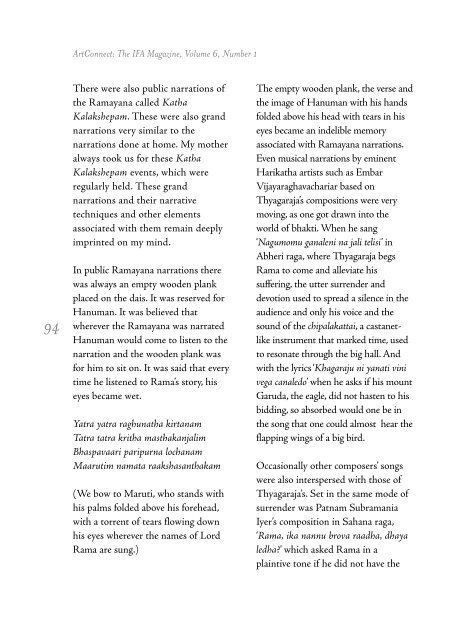Layout 3 - India Foundation for the Arts - IFA
Layout 3 - India Foundation for the Arts - IFA
Layout 3 - India Foundation for the Arts - IFA
You also want an ePaper? Increase the reach of your titles
YUMPU automatically turns print PDFs into web optimized ePapers that Google loves.
94<br />
ArtConnect: The <strong>IFA</strong> Magazine, Volume 6, Number 1<br />
There were also public narrations of<br />
<strong>the</strong> Ramayana called Katha<br />
Kalakshepam. These were also grand<br />
narrations very similar to <strong>the</strong><br />
narrations done at home. My mo<strong>the</strong>r<br />
always took us <strong>for</strong> <strong>the</strong>se Katha<br />
Kalakshepam events, which were<br />
regularly held. These grand<br />
narrations and <strong>the</strong>ir narrative<br />
techniques and o<strong>the</strong>r elements<br />
associated with <strong>the</strong>m remain deeply<br />
imprinted on my mind.<br />
In public Ramayana narrations <strong>the</strong>re<br />
was always an empty wooden plank<br />
placed on <strong>the</strong> dais. It was reserved <strong>for</strong><br />
Hanuman. It was believed that<br />
wherever <strong>the</strong> Ramayana was narrated<br />
Hanuman would come to listen to <strong>the</strong><br />
narration and <strong>the</strong> wooden plank was<br />
<strong>for</strong> him to sit on. It was said that every<br />
time he listened to Rama’s story, his<br />
eyes became wet.<br />
Yatra yatra raghunatha kirtanam<br />
Tatra tatra kritha masthakanjalim<br />
Bhaspavaari paripurna lochanam<br />
Maarutim namata raakshasanthakam<br />
(We bow to Maruti, who stands with<br />
his palms folded above his <strong>for</strong>ehead,<br />
with a torrent of tears flowing down<br />
his eyes wherever <strong>the</strong> names of Lord<br />
Rama are sung.)<br />
The empty wooden plank, <strong>the</strong> verse and<br />
<strong>the</strong> image of Hanuman with his hands<br />
folded above his head with tears in his<br />
eyes became an indelible memory<br />
associated with Ramayana narrations.<br />
Even musical narrations by eminent<br />
Harikatha artists such as Embar<br />
Vijayaraghavachariar based on<br />
Thyagaraja’s compositions were very<br />
moving, as one got drawn into <strong>the</strong><br />
world of bhakti. When he sang<br />
‘Nagumomu ganaleni na jali telisi’ in<br />
Abheri raga, where Thyagaraja begs<br />
Rama to come and alleviate his<br />
suffering, <strong>the</strong> utter surrender and<br />
devotion used to spread a silence in <strong>the</strong><br />
audience and only his voice and <strong>the</strong><br />
sound of <strong>the</strong> chipalakattai, a castanetlike<br />
instrument that marked time, used<br />
to resonate through <strong>the</strong> big hall. And<br />
with <strong>the</strong> lyrics ‘Khagaraju ni yanati vini<br />
vega canaledo’ when he asks if his mount<br />
Garuda, <strong>the</strong> eagle, did not hasten to his<br />
bidding, so absorbed would one be in<br />
<strong>the</strong> song that one could almost hear <strong>the</strong><br />
flapping wings of a big bird.<br />
Occasionally o<strong>the</strong>r composers’ songs<br />
were also interspersed with those of<br />
Thyagaraja’s. Set in <strong>the</strong> same mode of<br />
surrender was Patnam Subramania<br />
Iyer’s composition in Sahana raga,<br />
‘Rama, ika nannu brova raadha, dhaya<br />
ledha?’ which asked Rama in a<br />
plaintive tone if he did not have <strong>the</strong>


